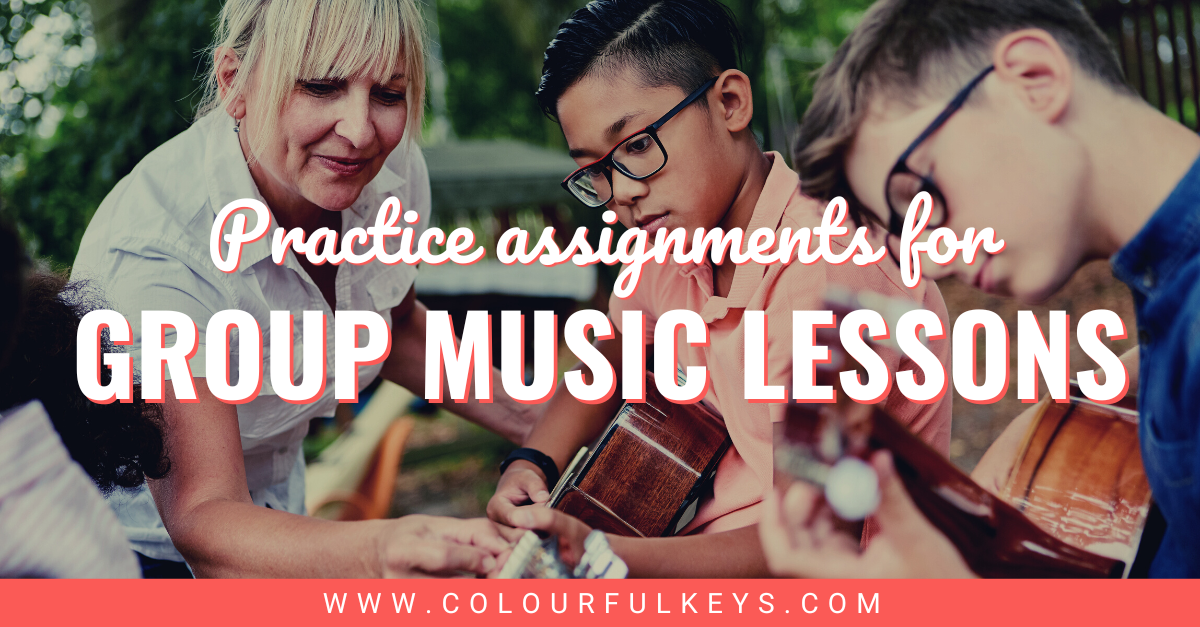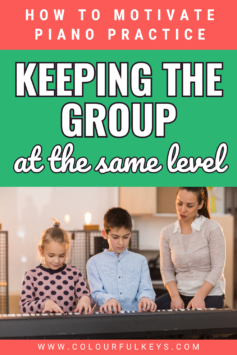
This article about practice assignments for group piano lessons was written by Melanie Bowes. Melanie is the Founder of KeyNotes Music, a group piano program, focusing on collaborative group learning in the foundation stages of piano. Having taught for many years as a school music teacher, Melanie brings all of her experience and knowledge together to help teachers deliver innovative and progressive group piano classes. Melanie is currently working towards a PhD in group piano teaching, researching the features that make it impactful and beneficial for children..
Any group of piano students learning together is a mixed level group. Even if you have a group of beginners, it’s not as though they all started playing on the same exact day, at the same exact moment. In addition, there’s no guarantee they’ll all understand and advance in unison. So how can we anticipate home practice assignments for group piano lessons?

From the very first lesson, it’s clear that students learn differently from each other, comprehend at different moments and develop skills at varied depths. We must adapt and strategise for these learners, their learning styles and their progress.
During the Lesson
As teachers, we need to have an overarching plan of objectives we want our students to develop over a certain timeframe. Once we have those objectives, we’ll know what to monitor and how to assess it.
Monitoring
The way that we monitor our students and their progress is key to ensuring that cumulative and progressive learning is taking place. We must plan lessons that build upon prior knowledge while taking into consideration the capabilities of our students.
This requires a lesson structure which:
- provides clear objectives and success criteria
- delivers activities that allow students to meet, and exceed, expectations
- offers real time feedback, while giving students an opportunity to demonstrate their understanding and skills
Without this clear understanding of where students are and where we want them to go, it would be impossible to know what to set as practice assignments for students in group piano lessons.
And don’t forget: We also need to let our students and piano parents know what the students are learning, the skills they’re developing and the concepts they’re working on.
Need help planning your lessons? The ‘Lesson Planning Level-Up’ resource is just the ticket! Enter your info below, and Nicola will send your very own copy directly to your inbox.

Subscribe to the newsletter and get the Lesson Planning Level-Up
Enter your details to subscribe to the newsletter for piano teachers with information, tips and offers.
I hate spam as much as you do! I will only send you emails related directly to piano teaching and you can unsubscribe at any time.
Members can download the ‘Lesson Planning Level-Up’ from the VMT Library. Not a member? You’re missing out on so much! Check it out and join today at vibrantmusicteaching.com.
What went well….
Once we’ve monitored progress, it’s important to communicate our observations with our students. The most impactful way to do this is to first focus on what went well.
Praise them for one specific aspect of their work or performance that met the objective for that lesson. For example: If someone managed to play their piece using a great staccato action, you point that action out (maybe active fingertips or lifting the arm) and say how proud you are that they achieved the very thing we were working on for this piece.
Pro tip: In the group setting, point out one student’s quality work. When you do this, your other students will undoubtedly work hard to exhibit the same thing that the applauded student did – that’s the power of the group setting!
Next Steps
The critiquing process isn’t finished simply because you tell a student what they’ve done right or wrong. Students in group piano lessons need to know what their next steps are to continue moving forward in the learning process and in their home practice assignments.
After I’ve pointed out a student’s success, I’ll choose one next step that the student should act on. This needs to be specific and based on the objectives for that lesson. Even if there are 10 things that need to be improved, choose the most significant one to highlight. Because, let’s be honest, they’ll only be able to focus on one thing at a time.
Pro tip: Even though this action step is meant for just that one student, it can often apply to others in the class, and it’s good that everyone is hearing it.
You can always spread the next steps between the different students if you feel they apply to many of them, so then the whole class will hear all the different areas of opportunity.
After the Lesson
Once we’ve monitored progress, it’s important to communicate our observations.
Notes for the Teacher
I like to make sense of my observations myself before sharing them with students and parents. We can then use these notes for future planning.
At the bottom of each of my lesson plans there’s a section for notes where I can write about anything that could use further improvement, or could be challenged further, and for which individuals.
Notes for Students and Parents
Assignments for home practice are an essential part of all piano lessons, whether they be individual or group. But if we’ve given everyone feedback that’s different, and they’ve met objectives to various extents, how do we write lesson notes to our students and parents that are going to be impactful and useful?
My Music Staff is critical to the way I manage practice assignments. After every lesson, I use My Music Staff to write group lesson notes which go to all of the parents in the class via email. This email describes what we did in the lesson and what the students need to practise at home. I’ll also outline the various difficulties of the piece we’re all working on, and provide links to practice videos that outline the different options for each piece.
If I need to, I’ll add an individual note to the email for a specific student (made so easy by the options in My Music Staff!) These individual notes are normally sent if I need to communicate something where they need extra support, or possibly even a stretch.
Fostering Independence and Self-Direction
Practice assignments require students in group piano lessons to show independence, self motivation and confidence, which are all developed during the lesson time.
Create Self-Led Challenges
In my group piano lessons, all students are working on the same piece. But there are many ways a student can practise the piece in order to make it more challenging, and I outline that in my after-lesson email.
For example, if a student has successfully played one version in class or quickly progresses in home practice, they might move on to playing a more difficult version. This meshes with the growth mindset we’ve developed as part of the lesson and learning structure.
Set Up Supports
It’s also important to make sure that any student who needs support is given the tools they need in order to practise independently. That might mean giving them “crutches” to use during their very first lessons. These may include:
- writing beats over the top of the rhythms
- giving more fingerings than are written onto the score
- creating demo videos which outline what the goals are and common mistakes and things to watch out for
Although the idea of these supports is sometimes criticised, I would argue that it’s more important that we’re enabling independence. So long as we have a plan to teach them the processes they need to remove the crutches, these students will engage and thrive so much more than if we refused to give them the extra help.
Pro tip: Creating practice videos of pieces we’re teaching can be time consuming, but it’s an excellent resource for students and parents – especially if we say what we’re looking for in each piece and some of the common mistakes. Parents are forever thankful for these videos, as they often say they don’t support their child during practice because they don’t know how.

How do you create meaningful practice assignments for group piano lessons?
Leave a comment to let us know.
If you liked this article, you’ll love Nicola’s hub page about Planning Lessons, with its very own section devoted to teaching group piano lessons.